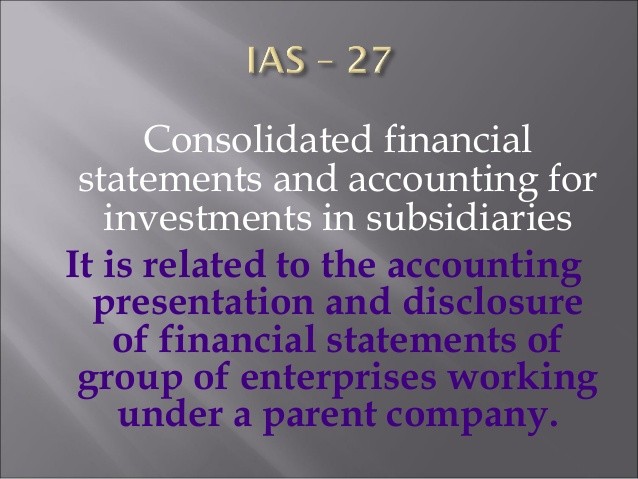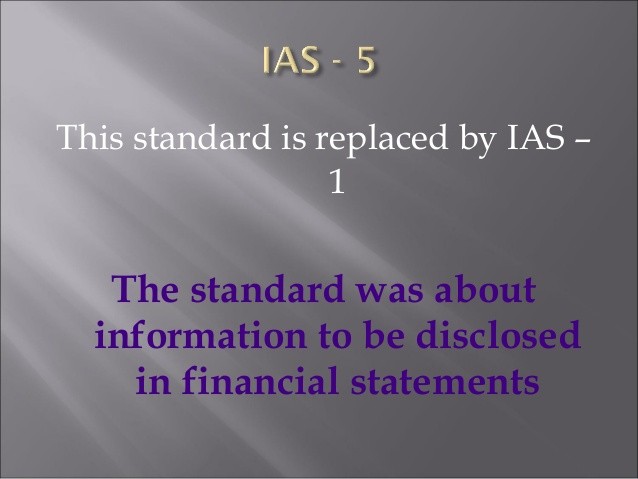Introduction to IAS 29 Financial Reporting in Hyperinflationary Economies IFRS Accounting
Post on: 10 Апрель, 2015 No Comment

This Standard shall be applied to the financial statements, including the consolidated financial statements, of any entity whose functional currency is the currency of a hyperinflationary economy.
In a hyperinflationary economy, reporting of operating results and financial position in the local currency without restatement is not useful. Money loses purchasing power at such a rate that comparison of amounts from transactions and other events that have occurred at different times, even within the same accounting period, is misleading.
This Standard does not establish an absolute rate at which hyperinflation is deemed to arise. It is a matter of judgement when restatement of financial statements in accordance with this Standard becomes necessary. Hyperinflation is indicated by characteristics of the economic environment of a country which include, but are not limited to, the following:
(a) the general population prefers to keep its wealth in non-monetary assets or in a relatively stable foreign currency. Amounts of local currency held are immediately invested to maintain purchasing power;
(b) the general population regards monetary amounts not in terms of the local currency but in terms of a relatively stable foreign currency. Prices may be quoted in that currency;
(c) sales and purchases on credit take place at prices that compensate for the expected loss of purchasing power during the credit period, even if the period is short;
(d) interest rates, wages and prices are linked to a price index; and
(e) the cumulative inflation rate over three years is approaching, or exceeds, 100%.
The restatement of financial statements
Prices change over time as the result of various specific or general political, economic and social forces. Specific forces such as changes in supply and demand and technological changes may cause individual prices to increase or decrease significantly and independently of each other. In addition, general forces may result in changes in the general level of prices and therefore in the general purchasing power of money.
The financial statements of an entity whose functional currency is the currency of a hyperinflationary economy, whether they are based on a historical cost approach or a current cost approach, shall be stated in terms of the measuring unit current at the end of the reporting period. The corresponding figures for the previous period required by IAS 1
Presentation of Financial Statements (as revised in 2007) and any
information in respect of earlier periods shall also be stated in terms of the measuring unit current at the end of the reporting period. For the purpose of presenting comparative amounts in a different presentation currency, paragraphs 42(b) and 43 of IAS 21 The Effects of Changes in Foreign Exchange Rates apply.
The gain or loss on the net monetary position shall be included in profit or loss and separately disclosed.
Historical cost financial statements
Statement of financial position
Statement of financial position amounts not already expressed in terms of the measuring unit current at the end of the reporting period are restated by applying a general price index.
Monetary items are not restated because they are already expressed in terms of the monetary unit current at the end of the reporting period. Monetary items are money held and items to be received or paid in money.
Assets and liabilities linked by agreement to changes in prices, such as index linked bonds and loans, are adjusted in accordance with the agreement in order to ascertain the amount outstanding at the end of the reporting period. These items are carried at this adjusted amount in the restated statement of financial position.
All other assets and liabilities are non-monetary. Some non-monetary items are carried at amounts current at the end of the reporting period, such as net realisable value and fair value, so they are not restated. All other non-monetary assets and liabilities are restated.
The impact of inflation is usually recognised in borrowing costs. It is not appropriate both to restate the capital expenditure financed by borrowing and to capitalise that part of the borrowing costs that compensates for the inflation during the same period. This part of the borrowing costs is recognised as an expense in the period in which the costs are incurred.
Statement of comprehensive income
This Standard requires that all items in the statement of comprehensive income are expressed in terms of the measuring unit current at the end of the reporting period. Therefore all amounts need to be restated by applying the change in the general price index from the dates when the items of income and expenses were initially recorded in the financial statements.
Current cost financial statements
Statement of financial position
Items stated at current cost are not restated because they are already expressed in terms of the measuring unit current at the end of the reporting period. Other items in the statement of financial position are restated in accordance with paragraphs 11 to 25.
Statement of comprehensive income
The current cost statement of comprehensive income, before restatement, generally reports costs current at the time at which the underlying transactions or events occurred. Cost of sales and depreciation are recorded at current costs at the time of consumption; sales and other expenses are recorded at their money amounts when they occurred. Therefore all amounts need to be restated into the measuring unit current at the end of the reporting period by applying a general price index.
Taxes
The restatement of financial statements in accordance with this Standard may give rise to differences between the carrying amount of individual assets and liabilities in the statement of financial position and their tax bases. These differences are accounted for in accordance with IAS 12 Income Taxes.

Statement of cash flows
This Standard requires that all items in the statement of cash flows are expressed in terms of the measuring unit current at the end of the reporting period.
Corresponding figures
Corresponding figures for the previous reporting period, whether they were based on a historical cost approach or a current cost approach, are restated by applying a general price index so that the comparative financial statements are presented in terms of the measuring unit current at the end of the reporting period.
Consolidated financial statements
A parent that reports in the currency of a hyperinflationary economy may have subsidiaries that also report in the currencies of hyperinflationary economies. The financial statements of any such subsidiary need to be restated by applying a general price index of the country in whose currency it reports before they are included in the consolidated financial statements issued by its parent. Where such a subsidiary is a foreign subsidiary, its restated financial statements are translated at closing rates. The financial statements of subsidiaries that do not report in the currencies of hyperinflationary economies are dealt with in accordance with IAS 21.
Selection and use of the general price index
The restatement of financial statements in accordance with this Standard requires the use of a general price index that reflects changes in general purchasing power. It is preferable that all entities that report in the currency of the same economy use the same index.
Economies ceasing to be hyperinflationary
When an economy ceases to be hyperinflationary and an entity discontinues the preparation and presentation of financial statements prepared in accordance with this Standard, it shall treat the amounts expressed in the measuring unit current at the end of the previous reporting period as the basis for the carrying amounts in its subsequent financial statements.
The following disclosures shall be made:
(a) the fact that the financial statements and the corresponding figures for previous periods have been restated for the changes in the general purchasing power of the functional currency and, as a result, are stated in terms of the measuring unit current at the end of the reporting period;
(b) whether the financial statements are based on a historical cost approach or a current cost approach; and
(c) the identity and level of the price index at the end of the reporting period and the movement in the index during the current and the previous reporting period.
Effective date
41 This Standard becomes operative for financial statements covering periods beginning on or after 1 January 1990.














